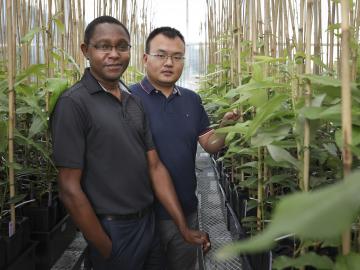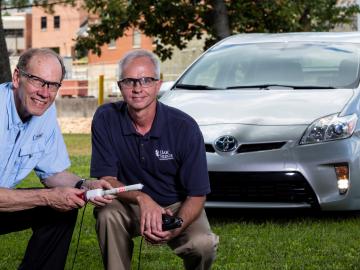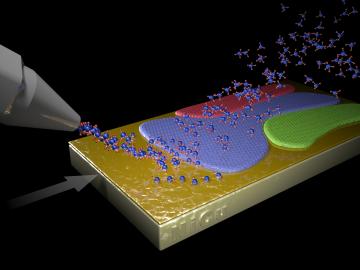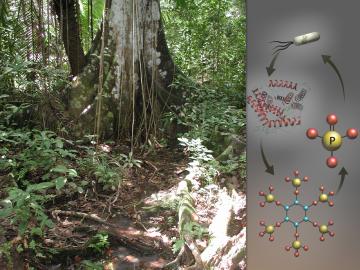
Filter News
Area of Research
- (-) Clean Energy (167)
- Advanced Manufacturing (13)
- Biological Systems (14)
- Biology and Environment (40)
- Biology and Soft Matter (1)
- Building Technologies (3)
- Chemistry and Physics at Interfaces (4)
- Climate and Environmental Systems (2)
- Computational Biology (4)
- Computational Engineering (2)
- Computer Science (4)
- Energy Frontier Research Centers (7)
- Energy Sciences (2)
- Fossil Energy (2)
- Fuel Cycle Science and Technology (1)
- Functional Materials for Energy (6)
- Fusion and Fission (17)
- Fusion Energy (2)
- Geographic Information Science and Technology (2)
- Isotope Development and Production (1)
- Isotopes (8)
- Materials (204)
- Materials Characterization (2)
- Materials for Computing (13)
- Materials Synthesis from Atoms to Systems (5)
- Materials Under Extremes (5)
- National Security (24)
- Neutron Science (77)
- Nuclear Science and Technology (24)
- Nuclear Systems Modeling, Simulation and Validation (1)
- Nuclear Systems Technology (1)
- Quantum Condensed Matter (1)
- Quantum information Science (1)
- Reactor Technology (1)
- Sensors and Controls (1)
- Supercomputing (107)
- Transportation Systems (5)
News Type
News Topics
- 3-D Printing/Advanced Manufacturing (28)
- Advanced Reactors (3)
- Artificial Intelligence (4)
- Big Data (1)
- Bioenergy (14)
- Biology (5)
- Biomedical (3)
- Biotechnology (2)
- Buildings (8)
- Chemical Sciences (10)
- Clean Water (1)
- Climate Change (6)
- Composites (5)
- Computer Science (9)
- Coronavirus (4)
- Critical Materials (4)
- Cybersecurity (3)
- Decarbonization (10)
- Energy Storage (26)
- Environment (13)
- Exascale Computing (2)
- Fossil Energy (1)
- Frontier (1)
- Fusion (1)
- Grid (9)
- High-Performance Computing (2)
- Isotopes (1)
- Machine Learning (4)
- Materials (17)
- Materials Science (11)
- Mercury (1)
- Microscopy (4)
- Molten Salt (1)
- Nanotechnology (5)
- National Security (4)
- Net Zero (1)
- Neutron Science (7)
- Nuclear Energy (4)
- Partnerships (8)
- Physics (1)
- Polymers (5)
- Quantum Science (1)
- Renewable Energy (1)
- Security (3)
- Simulation (1)
- Summit (2)
- Sustainable Energy (24)
- Transformational Challenge Reactor (3)
- Transportation (17)
Media Contacts
Scientists studying a valuable, but vulnerable, species of poplar have identified the genetic mechanism responsible for the species’ inability to resist a pervasive and deadly disease. Their finding, published in the Proceedings of the National Academy of Sciences, could lead to more successful hybrid poplar varieties for increased biofuels and forestry production and protect native trees against infection.

A futuristic experiment simulating warmer environmental conditions has shown that peatland vegetation responds to higher temperatures with an earlier and longer growth period.

Brixon, Inc., has exclusively licensed a multiparameter sensor technology from the Department of Energy’s Oak Ridge National Laboratory. The integrated platform uses various sensors that measure physical and environmental parameters and respond to standard security applications.

For decades, biologists have believed a key enzyme in plants had one function—produce amino acids, which are vital to plant survival and also essential to human diets. But for Wellington Muchero, Meng Xie and their colleagues, this enzyme does more than advertised. They had run a series of experiments on poplar plants that consistently revealed mutations in a structure of the life-sustaining enzyme that was not previously known to exist.

The U.S. Department of Energy’s Oak Ridge National Laboratory today unveiled Summit as the world’s most powerful and smartest scientific supercomputer.


Oak Ridge National Laboratory today welcomed a second group of technology innovators to join Innovation Crossroads, the Southeast’s only entrepreneurial research and development program based at a U.S. Department of Energy national laboratory. Selected through a me...

A new method to produce large, monolayer single-crystal-like graphene films more than a foot long relies on harnessing a “survival of the fittest” competition among crystals. The novel technique, developed by a team led by Oak Ridge National Laboratory, may open new opportunities for growing the high-quality two-dimensional materials necessary for long-awaited practical applications.

Four technologies developed at the Department of Energy’s Oak Ridge National Laboratory have earned 2018 Excellence in Technology Transfer Awards from the Federal Laboratory Consortium for Technology Transfer (FLC). The FLC is a nationwide network of more than 30...



